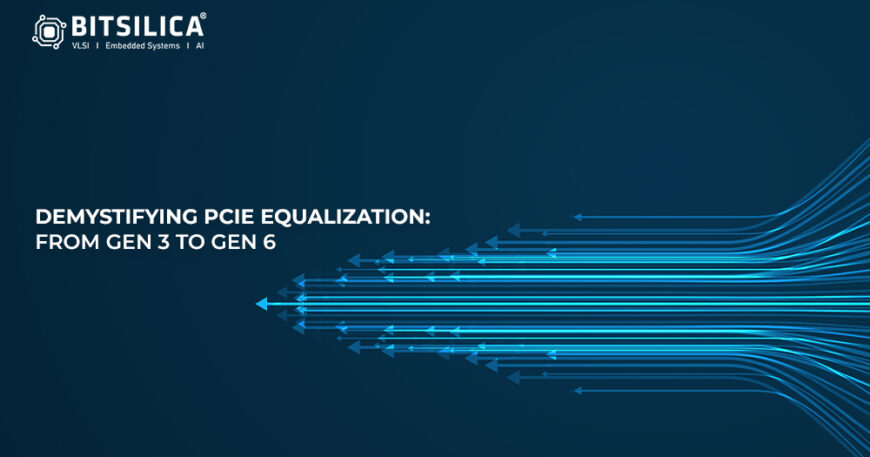Demystifying PCIe Equalization: From Gen 3 to Gen 6
The world of computer hardware is constantly evolving, with newer and faster technologies emerging regularly. One such crucial component in modern computers is the Peripheral Component Interconnect Express (PCIe) technology interface, which facilitates high-speed communication between various hardware components. Over the years, PCIe has undergone significant improvements, especially in the realm of equalization.
What Is Equalization in PCIe?
Equalization in PCIe is a fascinating concept that aims to combat signal distortion as data transmission speeds increase. As PCIe links upgrade, the channels become bandlimited, resulting in more signal distortion. Equalization was introduced in PCIe to mitigate or reduce these distortions. It is a crucial process that ensures data integrity and reliable communication between different hardware components.
Equalization in PCIe became prominent starting from PCIe Gen 3, although earlier generations used a method called deemphasis to minimize distortions at lower data rates, such as Gen 1 (2.5 GTps) and Gen 2 (5 GTps).
The Basics of Equalization in PCIe
Equalization primarily takes place in the Recovery state of the Link Training Status State Machine (LTSSM), a component of the Physical layer of PCIe. Here are some key points to understand about equalization in PCIe:
- Autonomous or Software-Based: Equalization can be initiated autonomously by hardware or through software-based mechanisms when the link does not support autonomous equalization.
- Root Port and Endpoint Adjustments: Both the root port and endpoint devices adjust their transmitter and receiver setups to enhance signal quality.
- Receiver’s Role: The receiver evaluates the incoming signal quality and suggests transmitter equalization parameters accordingly.
- Lane-Specific Equalization: Equalization happens for each lane in the LTSSM, and each lane may have different equalization values.
- Phases of Equalization: Equalization occurs in four phases, namely Phase 0, Phase 1, Phase 2, and Phase 3.
Phase 0
- Phase 0 is where the upstream port starts the equalization process.
- The link should maintain a minimum speed of 8 GTps to enter the equalization process.
- If the link is not at 8 GTps but aims to upgrade to this speed, it enters Phase 0 with an EC (Equalization Control) value of 00.
- Phase 0 involves the exchange of Tx preset and Rx Hint values to adjust transmitter settings.
- If the data rate changes, the downstream port goes to Phase 1, while the upstream port stays in Phase 0.
- If the upstream port receives two consecutive TS1s and achieves a BER (Bit Error Rate) of < 10^-4, it moves to Phase 1.
Phase 1
- Phase 1 involves the exchange of Full Swing (FS) and Low Frequency (LF) information between link partners.
- The receiver calculates and requests the next set of transmitter coefficients based on this information.
- If the DSP (Downstream Port) and USP (Upstream Port) Rx detect consecutive TS1s and are satisfied with signal quality, they both move to EC = 10b.
- If the required signal quality is achieved in this phase, the link sets EC to 00b and exits the equalization process.
Phase 2
- Phase 2 occurs after signal quality is obtained but may not be suitable for runtime operations.
- The endpoint tunes the Tx coefficient values of the root port.
- If the “Preset” bit is set, preset values are tuned; otherwise, Tx coefficient values need tuning, including Pre-cursor, Cursor, and Post-cursor coefficients.
- If the changed values are legal and meet necessary conditions, the link proceeds to the next phase; otherwise, it may need reinitialization.
- If satisfied, the link sets EC to 00b and exits equalization.
Phase 3
- Phase 3 is similar to Phase 2 but involves the root port tuning the endpoint’s Tx coefficients.
- This process continues until the downstream component’s receiver achieves a BER of < 10^-12, indicating a high-quality signal.
- If successful, the link sets EC to 00b, and the DSP exits the equalization process.
The Evolution of PCIe Equalization
Now, let’s explore how equalization in PCIe technology has evolved from Gen 3 to Gen 6:
- PCIe 3.0: Gen 3 introduced static equalization, primarily performed by the transmitter using 128/130 encoding. It involved amplitude adjustments in the signal.
- PCIe 4.0: Gen 4 brought dynamic equalization, where the receiver played a more active role. It focused on amplitude and timing adjustments of the signal.
- PCIe 5.0: Gen 5 continued with dynamic equalization performed by the receiver. It introduced Continuous Time Linear Equalization (CTLE), which effectively removed signals prone to distortion in the channel. PCIe 5.0 also adapted to channel changes during transmission.
- PCIe 6.0: Gen 6 maintained dynamic equalization, performed by the receiver. However, it introduced PAM4 encoding to double data rates compared to previous generations.
The Significance of Equalization Advancements
With each generation of PCIe, advancements in equalization techniques have played a crucial role in increasing data rates and compensating for channel distortions during transmission. These advancements have allowed for faster and more reliable communication between hardware components in modern computers.
In conclusion, equalization is a critical aspect of PCIe technology that ensures the integrity of data transmission in increasingly high-speed environments. As PCIe continues to evolve, we can expect even more innovative equalization techniques to further enhance performance and reliability in future generations of hardware.
Key Phrases: PCIe technology
Explore More: Exciting Developments in PCIe 6.0: Unveiling the FLIT Phenomenon





